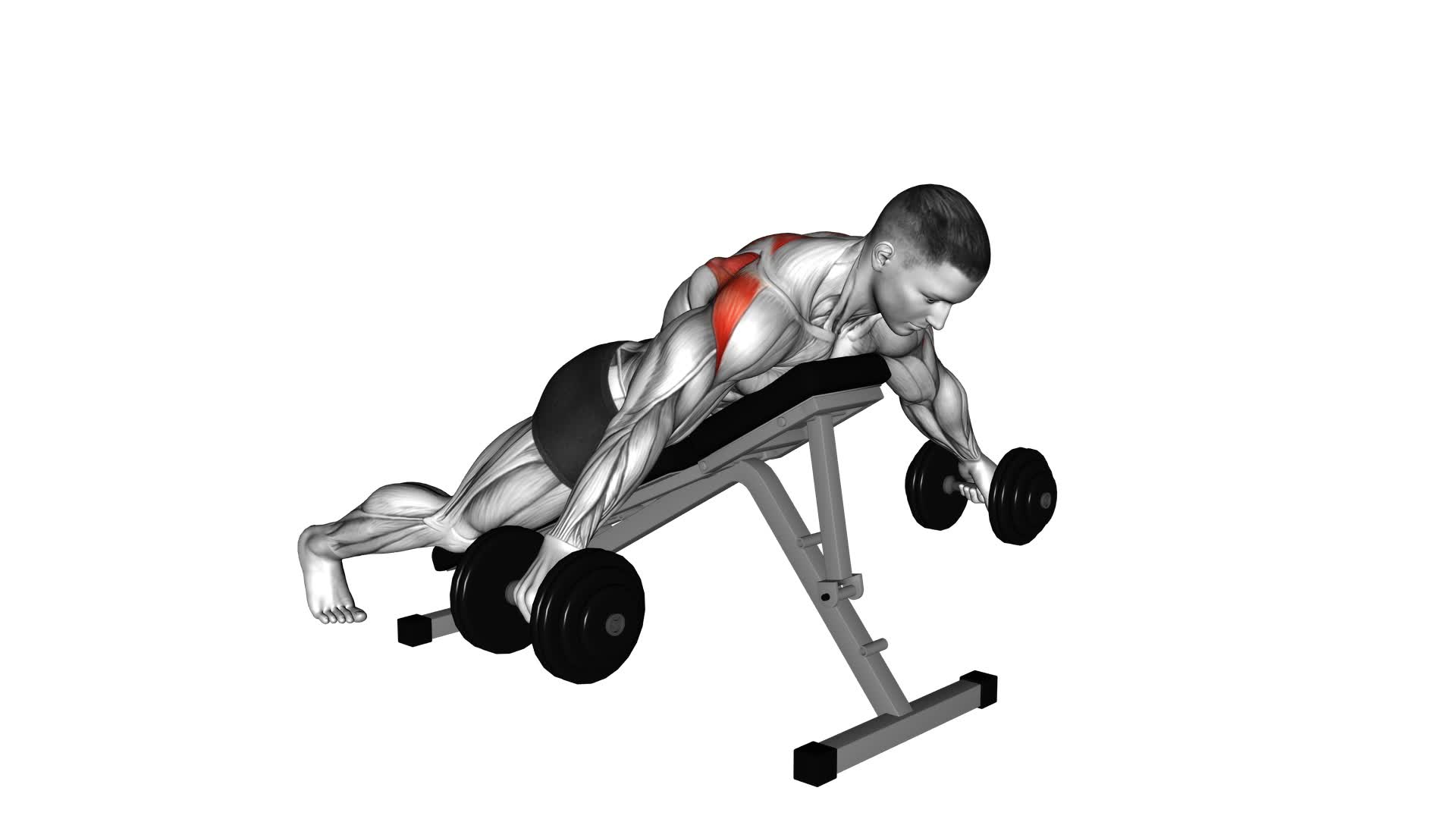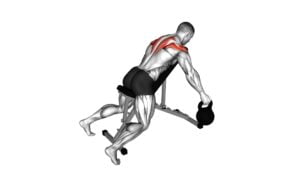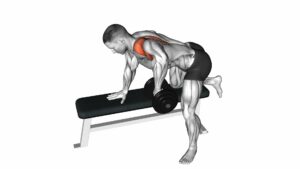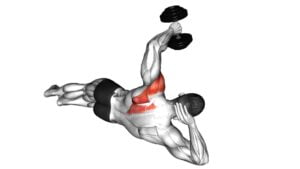Dumbbell Prone Rear Delt Swing – Video Exercise Guide & Tips

Are you looking to strengthen your rear delts? Then the dumbbell prone rear delt swing is the exercise for you! In this video exercise guide, we'll show you how to properly perform this movement to maximize results.
Watch This Exercise Video
With just a few simple equipment and set-up requirements, you'll be on your way to building strong and defined rear delts. Read on to learn the proper form, common mistakes to avoid, and tips for getting the most out of this exercise.
Let's get started!
Key Takeaways
- Targets the rear deltoid muscles
- Improves shoulder stability and posture
- Activates upper back and shoulder muscles
- Promotes better shoulder mobility
Benefits of the Dumbbell Prone Rear Delt Swing
You can strengthen your rear deltoids by performing the Dumbbell Prone Rear Delt Swing. This exercise offers numerous benefits that can enhance your training strategies.
One of the main advantages is that it specifically targets the rear deltoid muscles, helping to improve their strength and definition. By engaging these muscles, you can achieve better shoulder stability and posture, which is essential for various daily activities and sports performance.
Additionally, the Dumbbell Prone Rear Delt Swing also activates the muscles in your upper back and shoulders, including the trapezius and rhomboids. This can help improve overall upper body strength and muscular balance. The exercise also promotes better shoulder mobility, reducing the risk of injury and discomfort during other exercises or daily movements.
Incorporating the Dumbbell Prone Rear Delt Swing into your training routine can provide you with a well-rounded shoulder workout, targeting both the front and back deltoids. This balanced approach can help prevent muscle imbalances and promote a more symmetrical physique.
Now that you understand the benefits of the Dumbbell Prone Rear Delt Swing, let's move on to the next section, which will cover the equipment and set-up required for performing this exercise effectively.
Equipment and Set-Up for the Exercise
To effectively perform the Dumbbell Prone Rear Delt Swing, you'll need specific equipment and proper set-up. This exercise requires a pair of dumbbells that are appropriate for your fitness level. Start by selecting a weight that challenges you but allows you to maintain proper form throughout the movement.
To set up for the exercise, begin by lying face down on a flat bench. Position your feet shoulder-width apart and allow your arms to hang straight down, holding the dumbbells with an overhand grip. Make sure your palms are facing each other.
Before starting the exercise, ensure that your core is engaged, and your back is flat. This will help stabilize your body throughout the movement. Keep your head in a neutral position, looking towards the floor.
It's important to note that there are variations of the Dumbbell Prone Rear Delt Swing that can target different muscles. For example, you can perform the exercise on an incline bench or use a resistance band instead of dumbbells. These variations can add variety to your routine and help you target different angles of your rear deltoids.
Remember to always consult with a qualified fitness professional before attempting new exercises or using unfamiliar equipment. Proper equipment setup is crucial to ensure your safety and maximize the effectiveness of the exercise.
Proper Form and Technique
To ensure proper form and technique for the Dumbbell Prone Rear Delt Swing, it's crucial to maintain a stable core and flat back throughout the movement. Here are some key tips to help you maximize your results and improve your training strategies:
- Engage your core: Before starting the exercise, activate your abdominal muscles by pulling your belly button towards your spine. A strong core will provide stability and prevent any excessive arching of the lower back.
- Keep your back flat: Throughout the movement, make sure to maintain a neutral spine position, avoiding any rounding or overarching of the back. This will help target the rear deltoids effectively and reduce the risk of injury.
- Control the weights: Be mindful of the weights you choose and ensure that they're appropriate for your strength level. Start with lighter weights and gradually increase as you become more comfortable with the exercise. Focus on controlling the movement and avoid using momentum to swing the weights.
- Squeeze your shoulder blades: At the top of the movement, when your arms are fully extended, squeeze your shoulder blades together to activate the rear deltoids even more. This will help you develop better muscle definition and improve overall shoulder strength.
Variations and Modifications
Maintaining proper form and technique for the Dumbbell Prone Rear Delt Swing is crucial in order to optimize your training strategies and maximize results. However, once you have mastered the basic movement, you can explore variations and modifications to add variety and challenge to your workouts.
One way to increase the intensity of the exercise is by incorporating progressive overload. This means gradually increasing the weight of the dumbbells over time. By challenging your muscles with heavier weights, you stimulate greater muscle activation and promote strength gains.
Another variation is to perform the exercise on an incline bench. This changes the angle of the movement and targets the rear delts from a different perspective. It can also engage other muscles, such as the upper back and traps, to a greater extent.
You can also try performing the exercise unilaterally, using only one arm at a time. This can help address any muscle imbalances and provide a greater challenge to your stabilizing muscles.
Remember to always prioritize proper form and technique when incorporating variations and modifications. Start with lighter weights and gradually increase the difficulty as you become more comfortable and confident. By constantly challenging your muscles with different variations, you can keep your workouts fresh and continue to progress towards your fitness goals.
Common Mistakes to Avoid
One common mistake to avoid when performing the Dumbbell Prone Rear Delt Swing is using improper form and technique. To ensure success with this exercise, here are some tips to help you avoid common mistakes:
- Maintain proper body alignment: It's important to keep your spine neutral and your core engaged throughout the movement. Avoid arching your back or letting your shoulders hunch forward.
- Don't use excessive weight: Using heavy dumbbells can compromise your form and increase the risk of injury. Start with lighter weights and focus on performing the exercise correctly before gradually increasing the load.
- Avoid swinging the dumbbells: The key to this exercise is controlled movement. Avoid using momentum or swinging the dumbbells to lift them up. Instead, focus on engaging your rear deltoids to lift the weights.
- Keep your elbows slightly bent: Fully extending your arms during the movement can put unnecessary strain on your joints. Maintain a slight bend in your elbows throughout to reduce the risk of injury.
- Control the descent: When lowering the dumbbells, resist the urge to let them drop quickly. Maintain control as you lower them back to the starting position to maximize the effectiveness of the exercise.
Tips for Maximizing Results
To maximize your results with the dumbbell prone rear delt swing, it's crucial to focus on proper form techniques and effective training strategies. By ensuring that you maintain the correct posture and engage the targeted muscles throughout the exercise, you can optimize the effectiveness of each repetition.
Additionally, incorporating progressive overload and varying your training intensity will help to challenge your muscles and promote continuous growth and improvement.
Proper Form Techniques
To maximize your results with the dumbbell prone rear delt swing, it's important that you focus on proper form techniques. Paying attention to your form won't only ensure you're targeting the correct muscles, but it will also help prevent injury. Here are some tips to help you maintain proper form during this exercise:
- Common Mistakes:
- Avoid using momentum to swing the weights. Instead, focus on controlled movements.
- Don't hunch your back or round your shoulders. Keep your spine straight and engage your core for stability.
- Effective Training Strategies:
- Start with lighter weights and gradually increase the resistance as you become stronger.
- Keep your elbows slightly bent throughout the movement to engage the rear deltoids more effectively.
Effective Training Strategies
To maximize your results with the dumbbell prone rear delt swing, incorporate effective training strategies. Gradually increasing resistance is key to challenging your muscles and promoting growth over time. Start with a weight that allows you to perform the exercise with proper form and gradually increase the weight as you get stronger.
Another important training technique is to keep your elbows slightly bent throughout the movement. This helps to engage the rear deltoid muscles more effectively and prevents strain on the joints.
By following these strategies, you can enhance the effectiveness of your workout and achieve better results in developing your rear delts.
Keep pushing yourself and making progress to see continuous improvements in your strength and muscle development.
Frequently Asked Questions
How Many Sets and Reps Should I Do for the Dumbbell Prone Rear Delt Swing?
For the dumbbell prone rear delt swing, the number of sets and rep ranges depend on your fitness level and goals. It's generally recommended to start with 2-3 sets of 10-12 reps.
This exercise targets the posterior deltoids, helping to strengthen and tone them. By incorporating this exercise into your routine, you can improve shoulder stability, posture, and overall upper body strength.
Remember to always use proper form and gradually increase the weight as you progress.
Can I Use Resistance Bands Instead of Dumbbells for This Exercise?
Yes, you can use resistance bands instead of dumbbells for the prone rear delt swing exercise.
Using resistance bands can provide a different type of resistance and can help target your rear deltoids effectively.
The benefits of using resistance bands include increased muscle activation, improved joint stability, and the ability to adjust the resistance level easily.
Remember to maintain proper form and gradually increase the resistance as you progress.
Is It Necessary to Warm up Before Performing the Dumbbell Prone Rear Delt Swing?
It is necessary to warm up before performing any exercise to prevent injury and optimize performance. Warming up increases blood flow, raises body temperature, and prepares your muscles for the upcoming activity.
Benefits of warming up include improved flexibility, enhanced range of motion, and increased muscle activation.
If you're looking for alternatives to the dumbbell prone rear delt swing, you can try resistance bands or other exercises that target the rear deltoids.
Can the Dumbbell Prone Rear Delt Swing Help With Improving Posture?
Incorporating the dumbbell prone rear delt swing into your workout routine can have several benefits.
It can help improve your posture by strengthening the muscles in your upper back and shoulders, which can counteract the effects of slouching.
To perform this exercise properly, lie face down on a bench and lift the dumbbells out to the sides, squeezing your shoulder blades together.
Avoid swinging your body or using momentum to lift the weights.
Is This Exercise Suitable for Beginners or Should It Only Be Done by Experienced Individuals?
For beginners, it's important to approach the dumbbell prone rear delt swing with caution. Safety precautions should be taken to avoid injury. Start with lighter weights and focus on proper form before progressing to heavier weights.
It's recommended to consult with a fitness professional to ensure you're performing the exercise correctly and safely. Modifications and progressions can be made as you gain strength and experience.
Remember to listen to your body and gradually increase intensity over time.
Conclusion
In conclusion, the dumbbell prone rear delt swing is a highly effective exercise for targeting the rear deltoid muscles.
By using proper form and technique, along with variations and modifications, you can maximize your results and avoid common mistakes.
This exercise can be easily incorporated into your workout routine and is beneficial for strengthening and toning your shoulder muscles.
Remember to consult with a fitness professional before attempting any new exercise.

Author
Years ago, the spark of my life’s passion ignited in my mind the moment I stepped into the local gym for the first time. The inaugural bead of perspiration, the initial endeavor, the very first surge of endorphins, and a sense of pride that washed over me post-workout marked the beginning of my deep-seated interest in strength sports, fitness, and sports nutrition. This very curiosity blossomed rapidly into a profound fascination, propelling me to earn a Master’s degree in Physical Education from the Academy of Physical Education in Krakow, followed by a Sports Manager diploma from the Jagiellonian University. My journey of growth led me to gain more specialized qualifications, such as being a certified personal trainer with a focus on sports dietetics, a lifeguard, and an instructor for wellness and corrective gymnastics. Theoretical knowledge paired seamlessly with practical experience, reinforcing my belief that the transformation of individuals under my guidance was also a reflection of my personal growth. This belief holds true even today. Each day, I strive to push the boundaries and explore new realms. These realms gently elevate me to greater heights. The unique combination of passion for my field and the continuous quest for growth fuels my drive to break new ground.







